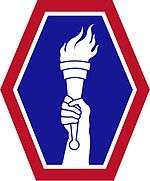Kesuke Miyagi
| Kesuke Miyagi 宮城健介 | |
|---|---|
|
Mr. Miyagi in The Karate Kid | |
| First appearance | The Karate Kid (1984) |
| Last appearance | The Next Karate Kid (1994) |
| Created by | Robert Mark Kamen |
| Portrayed by |
Pat Morita (films)[1] Fumio Demura (fight scenes in films) Robert Ito (animated series) |
| Information | |
| Nickname(s) |
Miyagi Yakuga Mr. Miyagi Miyagi-sensei |
| Title | Staff Sergeant (US Army) |
| Nationality | Japanese American |
Kesuke Miyagi (宮城健介 Miyagi Kesuke), known as Mr. Miyagi and also identified in the film The Karate Kid Part II as Nariyoshi Miyagi (宮城成義[2] Miyagi Nariyoshi), is a fictional karate master played by Japanese-American actor Pat Morita.[3] Mr. Miyagi mentors the characters Daniel LaRusso and Julie Pierce in the Karate Kid films. Morita earned an Academy Award nomination for his performance in the first film.[4]
The Karate Kid screenwriter Robert Mark Kamen stated that Mr. Miyagi was named after Chōjun Miyagi, the founder of Goju Ryu Karate-Do.[5] Also, the karate style depicted in the movies is the Goju Ryu style.
Fictional biography
Early life
An Okinawan Japanese immigrant to the United States, Kesuke Miyagi learned karate originally from his father, who had been a fisherman. Miyagi initially had a job working for the father of his best friend, Sato, who was also taught karate by Miyagi's father. Traditionally karate was only taught from father to son but Miyagi's father taught Sato after a request from his son. When Miyagi fell in love with a young woman named Yukie, who was arranged to marry Sato, Sato felt dishonored by this, and challenged Miyagi to a fight to the death. To avoid the fight, Miyagi left Okinawa and emigrated to the United States.
World War II military service
After first arriving in Los Angeles, he attended the University of California, Santa Barbara and was later interned in the Manzanar Japanese internment camp at the onset of World War II. During this time, Miyagi joined the U.S. Army and received the Medal of Honor (he was a member of the 442nd Regimental Combat Team, historically one of the most highly decorated regiments in the history of the United States Armed Forces, including 21 Medal of Honor recipients). While in the Army, he taught his Army commanding officer, Lt. Pierce, the art of karate. During his service, Mrs. Miyagi and their son died in the Manzanar camp due to complications during childbirth, a loss that haunted him for decades.[6] What Miyagi did during the time between the war and the first Karate Kid film is not fully known. Due to the events in some of the films it is entirely possible he resorted to drink and depression.
Awards and decorations
Here are the medals and service awards displayed on Staff Sergeant Miyagi's uniform in The Karate Kid.
|
| ||||||||||||||||||||||||||||||||||
The Karate Kid films
At the start of the first film, he works as a maintenance man in Daniel's apartment building.
In 1985, Miyagi learns that his father is dying, and returns to Okinawa, where he is reunited with Yukie. Sato relentlessly tries to goad Miyagi into a fight, but after Miyagi saves Sato from death during a typhoon, Sato renounces his hate and the two make peace.
In the third film, he and Daniel begin a business of growing bonsai trees.
In the fourth film, he mentors the orphaned granddaughter of his former commanding officer and teaches her to dispel her anger through the healing powers of the Martial Arts. In doing so, he becomes like a surrogate father to her.
Karate style
Mr. Miyagi has a deep philosophical knowledge of life and has extraordinary martial arts skill. In the second film, Mr. Miyagi explains that he is descended from Shimpo Miyagi, who was very fond of both fishing and sake. One day in 1625 while fishing and very drunk, he passed out on his fishing boat off the coast of Okinawa and ended up on the coast of China. Ten years later, Shimpo returned to Okinawa with his Chinese wife, his two kids, and the secret of Miyagi family karate. This implies that Shimpo Miyagi, like many Okinawan karate masters, was trained in Chinese martial arts during his stay in China. The secret of the Miyagi family karate appears to be a Den-den daiko, on which the drum technique is based. Other aspects of the style involve the crane technique, breathing technique, techniques from the kata Tensho (wax on wax off) and the kata Seiunchin.
Appearance in Reality Fighters
Mr Miyagi trains the player and is a hidden unlockable fighter in the game "Reality Fighters" for PS Vita. He wears his trademark outfit, uses a fishing pole as a weapon, repeatedly mentions his bonsai-growing, and makes subtle references to Karate Kid (including a fly-chopsticks gag).
Awards
Mr. Miyagi was inducted into the Fictitious Athlete Hall of Fame in 2015 in the Contributor Category.[7]
References
- ↑ Sullivan, Patricia (2005-11-26). "Noriyuki 'Pat' Morita, 73; Played 'Karate Kid' Teacher". Washington Post. Retrieved 2010-05-21.
- ↑ "A scene from The Karate Kid, Part II". Images.4chan.org. Retrieved 2015-07-09.
- ↑ Cowan, Jared (2014-06-17). "How a Movie Shot in the San Fernando Valley Made Us All The Karate Kid". L.A. Weekly. Retrieved 2015-07-09.
- ↑ "Holy trilogy of the 'Karate Kid'". ESPN. Retrieved 2010-05-21.
- ↑ The Karate Kid Blu-Ray
- ↑ Maslin, Janet (1984-06-22). "SCREEN 'KARATE KID,' BANE OF BULLIES". The New York Times. Retrieved 2010-05-21.
- ↑ "Fictitious Athlete Hall of Fame - Mr. Miyagi". Fictitious Athlete Hall of Fame.
.jpg)
